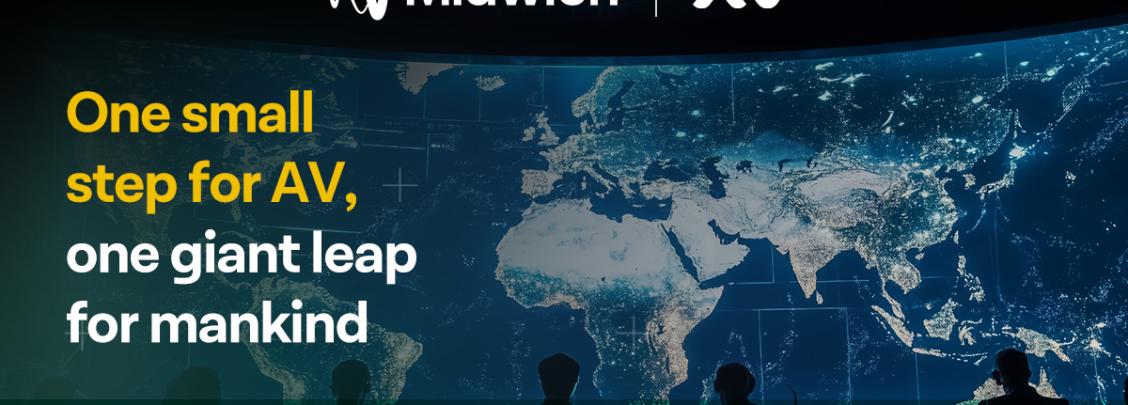One small step for AV, one giant leap for mankind | National Space Day blog
AV technology supports transformative work in a myriad of ways beyond Earth. For National Space Day, which aims to encourage young people to pursue careers in space-related jobs, we’re sharing five ways AV technology is used in space exploration, travel and research.
Space is a site of endless possibilities. Expanding in all directions, there’s so much for us to learn.
Space exploration and research offer us the opportunity to discover more about ourselves and the cosmos, increasing our ability to disperse knowledge and information.
Many kinds of engineers support these processes with groundbreaking technology.
Current trends include additive manufacturing or 3D printing to produce additional supplies after take-off and small satellites that weigh less than 500kg for remote sensing and communications.
Five AV technology applications in the space industry
1. Smart data processing and automation
Forget self-driving cars - think sophisticated space missions with no need for human intervention. AI use in autonomous spacecraft and data processing is on the rise in 2025.
Automation and machine learning accelerate decision-making processes both in space and in command centres on the ground.
AI is also useful for rapidly processing livestreams of weather data and generating high-resolution depictions of satellite and sensor data. This, combined with the 4K capabilities of smart displays, guarantees exceptional data visualisation.
Midwich offers intelligent product offerings that work together to make complete AV systems capable of rising to any challenge.
2. Space tourism
Anyone following the news will know that space tourism is no longer confined to the realms of science fiction; it’s become a reality.
Companies like Virgin Galactic and Blue Origin are working to make space travel commercially accessible, with Blue Origin launching a star-studded, all-female crew into space in mid-April.
The space tourism market is booming, attracting global investment.
AV technology helps create memorable experiences for passengers aboard these flights.
From live views of Earth to footage of passengers’ experiences, AV systems that are integral to our workplace, our shops and our healthcare systems are finding a new lease of life in space.
Even providing in-flight entertainment can provide that sense of familiarity and comfort, elevating the experience of space tourists.
3. Satellite imaging
Observing the far-off galaxies, stars and even the Earth we live on is what most of us think of when we discuss space missions. Using advanced AV technology, space professionals can observe celestial objects with high precision and accuracy.
Thanks to the enhanced capabilities of imaging systems, satellites also provide valuable insights into environmental monitoring.
Small satellites with visual and multispectral sensors are adept at remote-sensing missions observing Earth from space. AV technology in these small satellites delivers higher-resolution images and multispectral data, which is ideal for climate research and disaster management.
This forms an essential piece of the puzzle in climate activism, increasing our knowledge of the ongoing climate crisis.
Fun fact!
AV technology also has uses in astrophotography. Camera filters such as the Hoya STARSCAPE cut light pollution from artificial lights, which is good news for space enthusiasts on the ground looking to capture flawless photography of the stars and galaxies visible from Earth. The perfect way to develop or rekindle an appreciation of the solar system.
4. Speedy communications
Space is probably the last place you’d want to lose contact. AV technology enables astronauts to smoothly communicate with mission control centres in various scenarios.
Both in case of an emergency and for more routine mission updates and data transfer, advanced audio systems provide the ideal setup for communications, so space professionals stay connected no matter what.
5G connectivity facilitates seamless data transfer and multi-device integration.
5G-enabled networks with ultra-low latency transform the possibilities of space missions today, with hopes for a future where data can be managed directly from space.
5. Building public awareness
Sharing fresh updates and discoveries with the public is one of the many benefits of AV technology for the space industry. Technology can help raise awareness of the necessity of missions and make a case for funding within the industry.
Whether for live broadcasts or board presentations, AV helps engage more people in the exciting world of space travel.
This type of public education could play an instrumental role in inspiring the younger generation to pursue the sciences and possibly even a career in the space industry.
We hope you enjoyed our blog exploring the places where AV technology and space collide.
Want to discover more AV trends, industry insights and news? Read the latest edition of Connected Magazine here.

